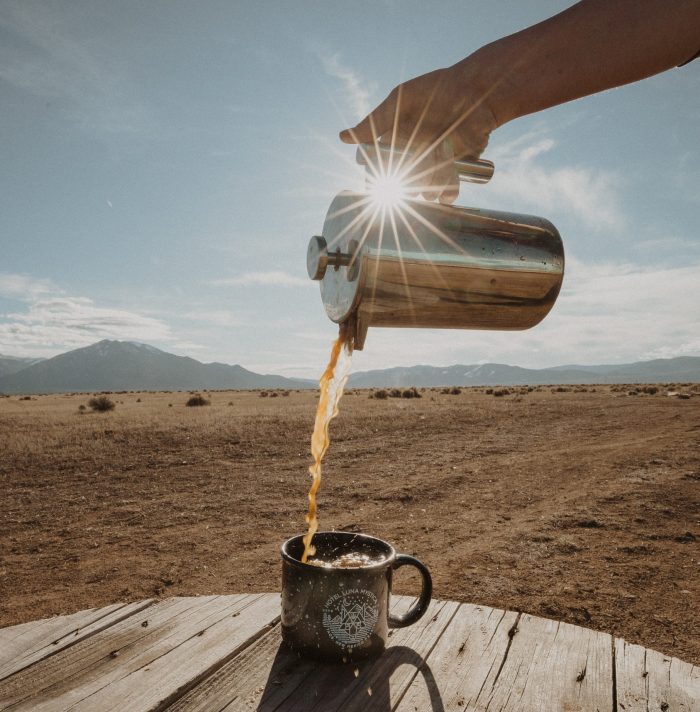Why do I make coffee in an old percolator?
It’s a meditation.
And it’s as simple as that, but it didn’t evolve simply.
I don’t drink coffee every day, but when I do, it is an absolute joy. This is because of the way I prepare it. Let me say as a caveat—I am not a coffee expert. I do not have the facts on the whole chemistry of it, and all that sciencey stuff behind why coffee tastes good if brewed a certain way.
All I know is: when I make it, it tastes delicious.
Step 1: I lift the stainless steel percolator off the shelf.
It used to live in the bin with our camping supplies down in the basement, but now resides uptown in the kitchen cupboard. It’s an old model, with a stem and basket set up inside, and a glass knob on top. I fill the percolator with lovely filtered water to the 7 line. As the water trickles out of my Berkey into the pot, I enjoy listening to the quiet sound. When filled, I then set the pot on the gas burner, and turn the burner on medium-high flame.
Step 2: I grind the coffee.
I use organic fair-trade beans—breakfast blend, a light roast. When I open the container, the smell is so invigorating. There is nothing like the smell of coffee beans. Coffee ranks in the top 10 best smells in the world, according to several surveys. “Even though you probably smell it every day, the aroma of ground coffee is still one of the best smelling scents imaginable. It’s possibly only topped by the smell of the air before it begins to rain.” (Ranker, 2020) I could dive into the container, I really could.
I don’t measure the beans, I eyeball it, and pour them into the grinder. The grinder does its work as I wait; it takes about 38 seconds. Once finished, I pour the fresh grinds into the basket and assemble it for the pot.
Step 3: Brewing.
This takes place after I place the basket into the pot. I leave the burner on medium, maybe lower it just a tad, and go about my morning sadhana. The water will boil in its own time. I sit and meditate 5, maybe 10, minutes. At some point, I will hear the coffee begin to perc. A familiar sound, a low growl, almost like a hungry belly rumbling, or a car engine starting on a cold winter’s morn.
I rise from my seated meditation and resist the urge to skip to the stove. Pause, walk to the pot, and see the happy, light brown liquid percolating in the glass bulb. It’s not water anymore, but it’s not coffee yet. I lower the burner to low, so it takes a few seconds between percs, and set the timer for five minutes.
Step 4: Waiting.
I return to my daily routine: tongue scraping, oil pulling, going outside to spit my oil out and to walk barefoot on the ground, check the garden. If it’s fall or winter, look at the sky, or watch for the birds. Waiting. Some days I will sit and do nothing.
Step 5: Timer rings; coffee is ready!
It has been about 30 minutes since the whole process began. But I cannot, and will not, slam the burner into off and start dumping the hot brew into the mug hastily and without thinking.
I will lift the lid, and let it begin to cool. I will allow the rest of the water in the basket to drain. I will retrieve my mug, gently pour some homemade oat milk into the bottom of it, and remove the basket from the pot carefully with a hot pad. Then I will pour, so focused and deliberate, as if the stream of steaming brown liquid is the cure for all that ails the world.
The first sip will be taken only after fully inhaling the smell, softly swallowing the delicious warm comfort of patient pauses, and slow, serene satisfaction.
Some tips for the aspiring coffee meditator:
>> Find your pot, and choose wisely! Something old, maybe a family heirloom or a thrift shop find
>> Set aside the time. Maybe get up earlier, or rearrange your morning routine to allow for the time to brew
>> Use your senses. Notice the sensations: pause and focus on the texture of your mug as you hold it, the aroma of the brewing coffee, the taste, temperature, sounds, and all that you see. It’s part of the meditation to stop and be aware of all five senses
>> Slow it down. It may seem counter to all that coffee culture signifies, but to truly appreciate the meditative quality of this exercise, it’s essential.
I’m not saying this is the only way, the best way, or even a good way. But it’s right for me. Admittedly, I used to drink my minimum two cups a day, in a flash, right off the Mr. Coffee plastic digital machine, feeling jazzed about the day. It was a ritual, but much like the other rituals in my mornings back then, I paid no attention, the same way I would brush my teeth or take a shower and not even remember doing it.
Then I went through a 10-year period of only drinking tea. Coffee was no longer my speed; caffeine no longer my drug of choice. Herbal tea, steeping hot, sweetened with raw honey, or over ice—that was my jam.
At some point, a couple of my kids starting working at the local coffee shop. I would stop in to visit, order my tea. After some time, I began to taste the coffee.
Should I go back?
It was like running into an old flame. The feelings are there, but I am different now. That’s why I make the coffee in the percolator.












Read 6 comments and reply